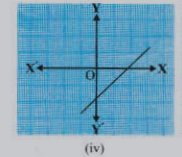Form the pair of linear equations in the following problems, and find their solutions (if they exist) by the elimination method : If we add 1 to the numerator and subtract 1 from the denominator, a fraction reduces to 1. It becomes 1/2 if we only add 1 to the denominator. What is the fraction?Solution in Punjabi
Step by step video & image solution for Form the pair of linear equations in the following problems, and find their solutions (if they exist) by the elimination method : If we add 1 to the numerator and subtract 1 from the denominator, a fraction reduces to 1. It becomes 1/2 if we only add 1 to the denominator. What is the fraction? by Maths experts to help you in doubts & scoring excellent marks in Class 10 exams.
Updated on:21/07/2023Topper's Solved these Questions
Similar Questions
Aftab tells his daughter, “Seven years ago, 1 was seven limes as old as you were then. Also, three years from now, 1 shall be three times as old as you will be." (Isn't this interesting?) Represent this situation algebraically and graphically.
View Solution(Rolling of a pair of dice) : Suppose your teacher challenges you to the following guessing game: She would throw a pair of dice. Before that you need to guess the sum of the numbers that show up on the dice. For every correct answer, you get two points and for every wrong guess you lose two points. Whal numbers would be the best guess?
View SolutionIn general, given a polynomial p(x) of degree n, the graph of y = p(x) intersects the x-axis atmost n points. Therefore, a polynomial p(x) of degree n has atmost n zeroes:

View SolutionFrom the pair of linear equations in the following problems, and find their solutions (if they exist) by the elimination method:(i) If we add 1 to the numerator and subtract 1 from the denominator, a fraction reduces to 1. It becomes 12if we only add 1 to the denominator. What is the fraction?
View SolutionThe sum of the numerator and the denominator of a fraction is 20 if we subtract 5 from the numerator and 5 from denominator, then the ratio of the numerator and the denominator will be 1:4. Find the fraction.
View SolutionIf we add 1 to the numerator and subtract 1 from the denominator, a fraction becomes 1. It also becomes 1/2 if we only add 1 to the denominator. What is the fraction?
View Solutionवह भिन्न के अंश तथा हर दोनो में 1 जोड़ने पर भिन्न 1/4 हो जाती है। यदि अंश तथा हर दोनों में 2 जोड़ा जाए तो भिन्न 1/3 हो जाती है तो भिन्न अंश तथा हर का योग ज्ञात करें:
View Solutionएक भिन्न के अंश मे से 4 घटाने पर हर में 1 जोड़ने पर भिन्न 16 हो जाती है। यदि उनके अंश तथा हर में क्रमशः 2 और 1 जोड़े जाते है तो यह 13 हो जाती है । भिन्न के अंश तथा हर का ल0स0 ज्ञात करें।
View Solutionयदि हम अंश में 1 जोड़ दें तथा हर में से 1 घटा दें तो भिन्न 1 में बदली जाती है । यदि हर में 1 जोड़ दें तो यह 12 हो जाती है । वह भिन्न क्या है ?
View Solutionसमस्याओ में रेखिक समीकरणों के युग्म बनाइए और उनके हल (यदि उनका अस्तित्व हो ) विलोपन विधि से ज्ञात कीजिए :
यदि हम अश में 1 जोड़ दे तथा हर में से 1 घटा दे , तो भिन्न 1 में बदल जाती है । यदि हर में 1 जोड़ दे तो यह 12 हो जाती है । वह भिन्न क्या है ।
View Solutionयदि किसी भिन्न के हर में 1 जोड़ने पर वह 12 हो जाता है तो अंश से 2 घटाने पर 13 हो जाता है तो भिन्न ज्ञात करे।
View SolutionForm the pair of linear equations in the following problems, and find their solutions (if they exist) by the elimination method :
If we add 1 to the numerator and subtract 1 from the denominator, a fraction reduces to 1. it becomes 12 if we only add 1 to the denominator. What is the fraction ?
View Solutionनिम्नलिखित समस्याओं के लिए रैखिक समीकरणों के युग्म बनाइए और निराकरण विधि से उनके हल (यदि हों) ज्ञात कीजिए : (xiv) यदि हम अंश 3 जोड़ें और हर में से 2 घटाएं, तो भिन्न 2 बन जाती है। यह12 भी बन जाती है यदि हम हर में | जोड़ें और भिन्न ज्ञात कीजिए।
View SolutionFrom the pair of linear equations in the following problems, and find their solutions (if they exist) by the elimination method:(i) If we add 1 to the numerator and subtract 1 from the denominator, a fraction reduces to 1. It becomes 12if we only add 1 to the denominator. What is the fraction?
View SolutionForm the pair of linear equations in the following problems, and find their solutions (if they exist) by the elimination method :
If we add 1 to the numerator and subtract 1 from the denominator, a fraction reduces to 1. It becomes 12 if we only add 1 to the denominator. What is the fraction ?
View SolutionA fraction becomes 1/3 if 1 is subtracted from both numerator and the denominator. If 1 is added to both the numerator and the denominator it becomes 1/2. Find the fraction.
View Solution
